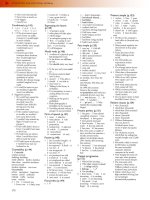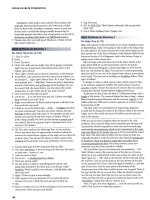105 2018 IELTS FOUNDATION reading thionline PROGRESS TEST5
Bạn đang xem bản rút gọn của tài liệu. Xem và tải ngay bản đầy đủ của tài liệu tại đây (234.24 KB, 3 trang )
Khóa IELTS FOUNDATION
GV: Hồng Hạnh
Facebook: HongHanhIELTSMoon.vn
IELTS FOUNDATION
PROGRESS TEST 5
VIDEO và LỜI GIẢI CHI TIẾT chỉ có tại website MOON.VN
[Truy cập tab Tiếng Anh cho Tân sinh viên – Khóa: IELTS FOUNDATION
SECTION 1
PABLO PICASSO
Pablo Picasso was one of the greatest artists of the 20th century. He experimented in many different styles
and changed the world of art during his time.
Early Life
Pablo Picasso was born in Malaga, Spain in 1881 . His father was a drawing teacher. At 10 Pablo became
his father’s pupil and at the age of 13 he held his first exhibition.
His family moved to Barcelona in 1895 where Pablo joined an art academy. In his early period the young
artist painted life as he observed it around him – in cafes and on the streets. As a young man he took
interest in masterpieces of famous artists like El Greco and de Goya. At the turn of the century, Picasso
went to Paris, which was, at that time, the centre of art and literature.
Blue and Rose period
In 1901 a close friend of Picasso shot himself. This had a great impact on Pablo. He was very sad and
began painting his pictures in grey and blue tones instead of bright, vivid colours. This part of his career is
called his Blue Period (1901 – 1904).
Later on, he changed his painting style and started using more earth colours – rose, pink or brown. He liked
to paint pictures of circus life with dancers and acrobats. This Rose Period lasted until 1907.
Civil War
In 1936 Civil War broke out in Spain. During this period he painted his masterpiece Guernica . It shows
the terrified people of the ancient Spanish town which was bombed during the Civil War. Picasso was
shocked by this inhuman act and in his painting he shows people running in the streets and screaming with
their mouths wide open. To display his sadness and anger he used only black and white as well
as shades of grey.
During World War II Picasso lived in Paris which, at that time, was under Nazi occupation. The Nazis
didn’t like his modern paintings and Picasso had to hide them in a secret vault in the Bank of France.
Later life
After the war Picasso moved to a big house in the southern part of
France. There,
he continued experimenting with paintings and sculptures. He continued his work up to his death in 1973.
Picasso was known as a very moody person and he also displayed this in his paintings. Sometimes he
was thoughtful, even sad, and at other times he could be very humorous. Picasso was never satisfied with
his own work and he never stopped experimenting. For his great imagination and skill he is called “El
Maestro” of modern art.
Moon.vn - Học để khẳng định mình
1
Hotline: 0432 99 98 98
Khóa IELTS FOUNDATION
GV: Hồng Hạnh
Facebook: HongHanhIELTSMoon.vn
Questions 1-10: Gap fill
Fill in the table below with NO MORE THAN ONE WORD.
1881
1891
1895
Late 1890s
1901 – 1904
1907
Pablo Picasso was born in (1)________
He became his father’s (2)_________ and held his first (3)_________ 3 years later.
Picasso’s family moved to (4)________. There he joined an (5)_________ academy,
painting his life as he (6)_________ it around him.
He went to (7)___________ - the center of art and literature
Picasso’s (8)_________ Period. He was influenced by the death of his
(9)______friend.
Picasso ended his (10)_________ Period.
Question 11-13: Short answers
Find the information in the passage and answer the following questions with NO MORE THAN THREE
WORDS.
11. What colors did Picasso use in his masterpiece Guernica?
12. Where did he hide his paintings during World War II?
13. What is he called for his imagination and skill?
SECTION 2
YOUR LOCKED MEMORIES
A person’s memory can be like a mansion with many, many rooms. Some of the rooms you visit
frequently, while others you may not enter for many years. As you age, some of these rooms may change,
and you may remember things slightly differently than how they actually happened. In other cases, the
rooms may stay the same, but the doors may become locked. Sometimes these rooms can only be unlocked
if you find a special key. Some of these rooms you may enjoy visiting; some of them, you may just wish
the door stayed shut.
One of the keys that can often unlock a person’s memory is a specific sensory input—something you can
see, smell, touch, taste, or hear. There is the famous case of the novelist Marcel Proust, who tasted a
madeleine—a kind of cookie—and it caused him to suddenly remember an enormous amount of his
childhood, memories that had previously been locked away. He went on to write a seven‐volume novel
called In Search of Lost Time, in which he explored these memories and what they meant to him. Proust
might not have written these volumes exactly as they are had he not eaten that fateful madeleine.
As Proust demonstrates, while we can consciously summon certain memories—for example, if you try to
think of your mother’s face, you can almost certainly do it—there are others that visit us involuntarily. This
has to do with how the human brain is wired. While much of the brain is still mysterious to scientists, it has
been determined that the memory center of the brain, where memories are made and stored, is closely
linked to the sensory center, where the brain controls and processes the body’s senses. A certain sensory
input, such as Proust’s cookie, may fire up not just the sensory center, but the memory center, too.
Questions 14 - 20
Decide whether these statements are TRUE (T) or FALSE (F)
14. To unlock a person’s memory, there needs to be a specific sensory input.
15. Memories are made and stored in the memory center of the brain.
16. Marcel Proust ate a madeleine and it made no difference for him to remember his locked memories.
17. While we try to remember something, there will be some memories that involuntarily come to our minds.
18. A certain sensory input only activates the sensory center.
Moon.vn - Học để khẳng định mình
2
Hotline: 0432 99 98 98
Khóa IELTS FOUNDATION
GV: Hồng Hạnh
Facebook: HongHanhIELTSMoon.vn
19. Marcel Proust is a scientist.
20. The brain controls and processes the body’s senses in the sensory center.
SECTION 3
Questions 21-23
Quickly scan the reading to answer the questions below with NO MORE THAN TWO WORDS AND/OR A
NUMBER. Then read again to check your answers.
21. Who is Becca Levy?
22. On average, how long do over-65-year-olds watch TV for each day?
23. What would be better redirected into reading books?
PEOPLE WHO READ LIVE LONGER
New research shows that people who read a lot live longer. The study was carried out by researchers from
Yale University in the USA. The researchers said reading keeps the mind active, helps reduce stress and
makes us take better care of our health. The researchers said that books help the brain more than
newspapers and magazines, but any kind of reading will help us to live longer. Even reading for half an
hour a day could help us to live longer. In the study, researchers looked at the lifestyles of 3,500 men and
women over a 12-year period. They looked at their reading habits, health, lifestyle and their education. All
of the people were at least 50 years old at the start of the research.
The study is in the journal 'Social Science and Medicine'. It found that people who read for up to 3.5 hours
a week were 17 per cent less likely to die during the study’s 12-year research period than those who read
no books. Those who read for more than 3.5 hours a week were 23 per cent less likely to die. Researcher
Becca Levy said: "Older individuals, regardless of gender, health, wealth or education, showed the survival
advantage of reading books." She suggested people swap watching TV for reading to live longer. She said:
"Individuals over the age of 65 spend an average of 4.4 hours per day watching television. Efforts to
redirect leisure time into reading books could prove to be beneficial."
Questions 24 -30: Multiple Choice.
Choose the best answer for each question.
24. Which university carried out the research?
a) Sorbonne
b) Harvard
c) Oxford
d) Yale
25. What does the research say reading reduces?
a) health
b) free time
c) intelligence
d) stress
26. What does the article say is better than magazines and newspapers?
a) books
b) journals
c) manga
d) biographies
27. How many men and women did researchers look at?
a) 35,000
b) 13,500
c) 3,500
d) 350
28. How old were the men and women at the start of the research?
a) 36
b) 50 or older
c) over 65
d) between 12 and 50
29. What is 'Social Science and Medicine'?
a) a journal
b) a website
c) a university department
d) a book
30. How long was the research for?
a) 23 years
b) 17 years
c) 12 years
d) 3.5 years
Giáo viên Hồng Hạnh
Nguồn
Moon.vn - Học để khẳng định mình
3
Moon.vn
Hotline: 0432 99 98 98









